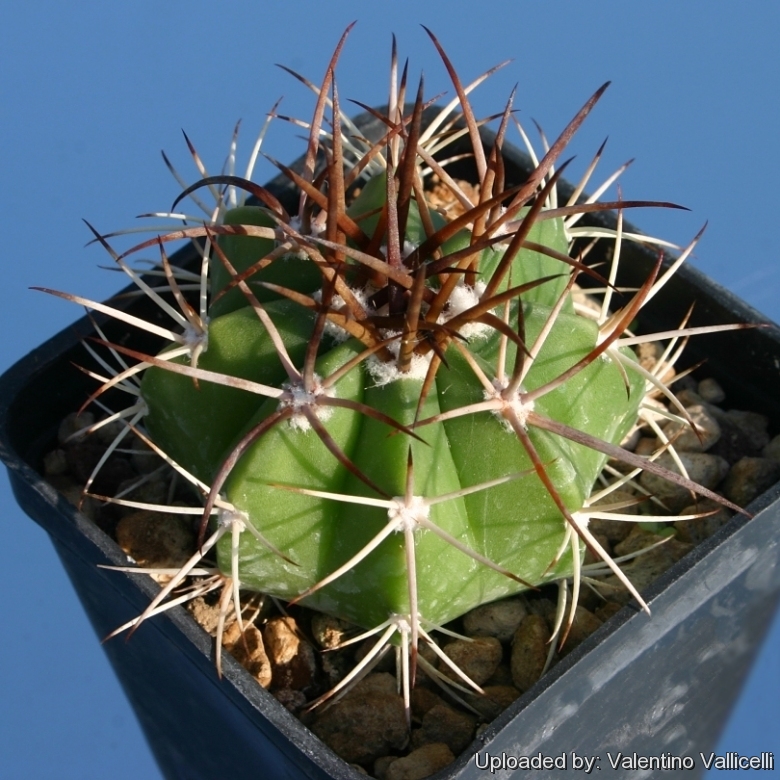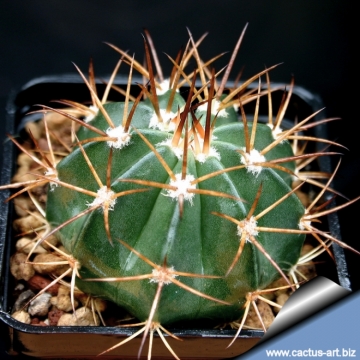Accepted Scientific Name: Melocactus zehntneri (Britton & Rose) Luetzelb.
Estud. Bot. Nordéste 3: 111 1926

Melocactus zehntneri subs. canescens Photo by: Valentino Vallicelli
Origin and Habitat: Brumado, Ourives, Palma de Monte Alto and adjacent areas, Bahia, Brazil
Synonyms:
See all synonyms of Melocactus zehntneri
back
Accepted name in llifle Database:Melocactus zehntneri (Britton & Rose) Luetzelb.Estud. Bot. Nordéste 3: 111 1926Synonymy: 17
back
Description: Melocactus zehntneriSN|20575]]SN|20575]] subs. canescens is one of the local form of the very variable Melocactus zehntneriSN|20575]]SN|20575]] distingusced from the standard species for it somewhat short cylindrical, often globular, stems with about 15 ribs. There are about seven stout brownish-gray radial spines, one central and the cephalia are densely covered by orange red bristle.
Habit: Usually stay solitary, mature plants are easily recognizable by their cephalia, that have a covering of wool and orange or red bristles, The immature plant looks like a smallish barrel cactus, and there is nothing in its appearance that would suggest a melocactus.
Stem: Strongly longitudinally ribbed depressed-globose or spheroid to cylindrical, pale to dull green, often glaucous, 10-50 cm high, 9-25 cm in diameter.
Ribs: 10-16 (rarely to 19) sharply acute.
Areoles: 1,2-2 cm apart.
Cephalia: 6-11 cm or more long, 6-10 cm in diameter, with dense, fine, pale pinkish red bristles and sparse or abundant white to creamy white wool.
Spines: Rather stout, yellow, brown, or reddish, overlaid with grey except at the dark tips.
Central spines: Usually 1 curved upward.
Radial spines: mostly 7, weakly to strongly curved backward, lower ones longest.
Flowers: Small inconspicuous (15-25 mm long, 4-13 mm across) pale to deep or purple, self pollinating, growing even with or well exserted at the top of the cephalium.
Fruit: Clavate, white or pale to deep lilac-pink, 12-20 mm long 4-8 mm in diameter.
Seeds: 1,2-1,3 x 1-1,1 mm noticeably tuberculate at end opposite hilum.
Subspecies, varieties, forms and cultivars of plants belonging to the Melocactus zehntneri group
Bibliography: Major references and further lectures
1) Stuart Max Walters “The European garden flora. 3.[Angiospermae], Dicotyledons. [Casuarinaceae to Aristolochiaceae]” Cambridge University Press, 1989
2) Edward Anderson “The Cactus family” Timber Press, Incorporated, 2001
3) David R Hunt; Nigel P Taylor; Graham Charles; International Cactaceae Systematics Group. "The New Cactus Lexicon" dh books, 2006
4) Urs Eggli, Leonard E. Newton "Etymological Dictionary of Succulent Plant Names" Birkhäuser 2004
5) Taylor, N. P. 1991. "The genus Melocactus (Cactaceae) in Central and South America." Bradleya 9: 1–80.
6) Nigel Taylor, Nigel P. Taylor, Daniela C. Zappi, “Cacti of Eastern Brazil” Royal Botanic Gardens, Kew, 15/gen/2004
7) Edgar Lamb, Brian Lamb “The Illustrated Reference on Cacti & Other Succulents” Volume 5 Blandford Press, 1978
8) E Haustein “Der Kosmos Kakteenfuehrer (the Kosmos Cactus Guide)” Balogh Scientific Books 01 December 1998
9) Clive Innes, Charles Glass “Cacti” Portland House, 1991
10) Machado, M., Taylor, N.P., Braun, P. & Zappi, D. 2013. Melocactus zehntneri. In: “IUCN 2013. IUCN Red List of Threatened Species.” Version 2013.2. <www.iucnredlist.org>. Downloaded on 04 December 2013.
 Melocactus zehntneri subs. canescens Photo by: Cactus Art
Melocactus zehntneri subs. canescens Photo by: Cactus Art Melocactus zehntneri subs. canescens Photo by: Cactus Art
Melocactus zehntneri subs. canescens Photo by: Cactus Art













